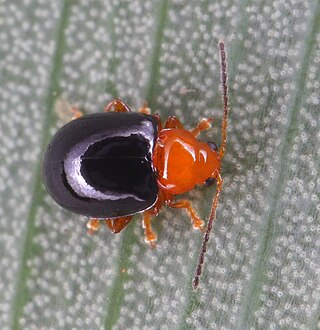
The Eumolpinae are a subfamily of the leaf beetles, or Chrysomelidae. It is one of the largest subfamilies of leaf beetles, including more than 500 genera and 7000 species. They are oval, and convex in form, and measure up to 10 mm in size. Typical coloration for this subfamily of beetles ranges from bright yellow to dark red. Many species are iridescent or brilliantly metallic blue or green in appearance.

Bromius obscurus, the western grape rootworm, is a species of beetle in the leaf beetle family. It is the only member of the genus Bromius. The distribution of the species is holarctic; it can be found in North America, wide parts of Europe, and Asia. The species is a known pest of grape vines in Europe and western North America.
Taophila is a genus of leaf beetles in the subfamily Eumolpinae. The genus is endemic to New Caledonia.

Eumolpini is a tribe of leaf beetles in the subfamily Eumolpinae. It is the largest tribe in the subfamily, with approximately 170 genera found worldwide. Members of the tribe almost always have a longitudinal median groove on the pygidium, which possibly helps to keep the elytra locked at rest. They also generally have a subglabrous body, as well as appendiculate pretarsal claws.

Typophorini is a tribe of leaf beetles in the subfamily Eumolpinae. The tribe contains approximately 100 genera, which are found worldwide. Members of the tribe are mainly characterized by notches on the tibiae of the middle and hind legs, which are sometimes referred to as antenna cleaners. They also generally have a subglabrous body, as well as bifid pretarsal claws.
Eupales is a genus of leaf beetles in the subfamily Eumolpinae. The genus contains only one species, Eupales ulema, which is found in Southeast Europe, mostly in Hungary, the Balkan Peninsula, and Turkey. Eupales is recognised as a primitive member of Eumolpinae, and it shares some features with the Spilopyrinae.
Dumbea is a genus of leaf beetles in the subfamily Eumolpinae. It is known from the South Province and Mont Panié of New Caledonia, and is named after Dumbéa, a town nearby Nouméa. This name was originally used by the French entomologist Charles Adolphe Albert Fauvel to house several species of Eumolpinae from New Caledonia, but Fauvel's Dumbea was unpublished and is a nomen nudum. The genus was established based on general proportions and body size, and may be polyphyletic or paraphyletic.
Montrouzierella is a genus of leaf beetles in the subfamily Eumolpinae. It is known from the South Province and Mont Panié of New Caledonia, and is named after Xavier Montrouzier, the pioneer entomologist of New Caledonia. The genus was established based on general proportions and body size, and may be polyphyletic or paraphyletic.
Samuelsonia is a genus of leaf beetles in the subfamily Eumolpinae. It is known from the South Province and Mont Panié of New Caledonia, and is named after Dr. G. Allan Samuelson of the Bishop Museum. The genus was established based on general proportions and body size, and may be polyphyletic or paraphyletic.
Cazeresia is a genus of leaf beetles in the subfamily Eumolpinae. It contains only one species, Cazeresia montana, found at 1,450 m and above on Mount Humboldt in the South Province of New Caledonia. Adults of C. montana were found on Dracophyllum involucratum, a species of plant in the family Epacridaceae. According to Jolivet et al. (2005), most probably the larvae feed on the roots of this plant. The genus is named after Sylvie Cazères, an assistant to the Pocquereux entomological group from the Institut Agronomique néo-Calédonien. Sylvie Cazères collected specimens of C. montana and other species of leaf beetles.
Edusella is a genus of leaf beetles in the subfamily Eumolpinae. It mainly occurs in Australia, with a single species occurring in New Caledonia.
Stethotes is a genus of leaf beetles in the subfamily Eumolpinae. It is distributed in Southeast Asia and the Western Pacific.

Dematochroma is a genus of leaf beetles in the subfamily Eumolpinae. It is mostly distributed in New Caledonia, though it is also found on Lord Howe Island, Norfolk Island and Timor. Adult beetles are often found at night feeding on leaves, and the larvae eat roots.
Bohumiljania is a genus of leaf beetles in the subfamily Spilopyrinae. It is endemic to New Caledonia. It is named after Czech entomologist Bohumila Špringlová.
Kumatoeides is a genus of leaf beetles in the subfamily Eumolpinae. The genus is endemic to New Caledonia. The genus was first erected in 2018 by Spanish entomologist Jesús Gómez-Zurita. The generic name is the Latin transliteration of the Greek adjective κυματοειδής, meaning "corrugated", referring to the regular striae on the elytra of the beetles.
Tricholapita is a genus of leaf beetles in the subfamily Eumolpinae. The genus is endemic to New Caledonia.
Horniolus dispar, is a species of lady beetle found in Sri Lanka.

Thasycles is a genus of leaf beetles in the subfamily Eumolpinae. It is endemic to New Caledonia. For a long time it was treated as a synonym of Dematochroma, until it was reinstated as a valid genus in 2022.

Stuckenbergiana is a genus of flea beetles belonging to the family Chrysomelidae. There is a single described species, Stuckenbergiana glabrata, which is found in South Africa.






